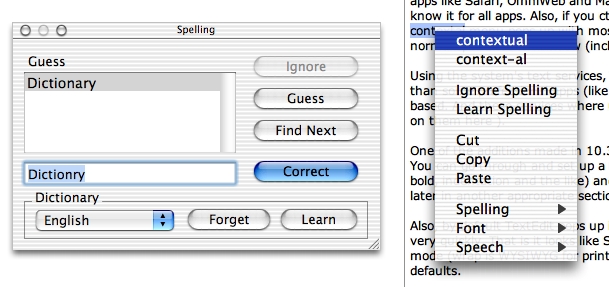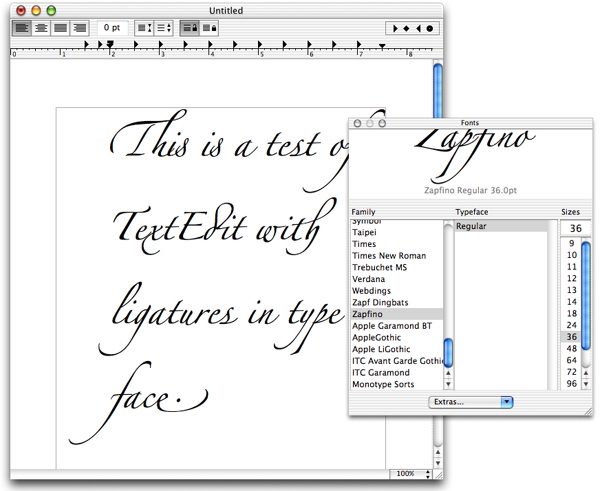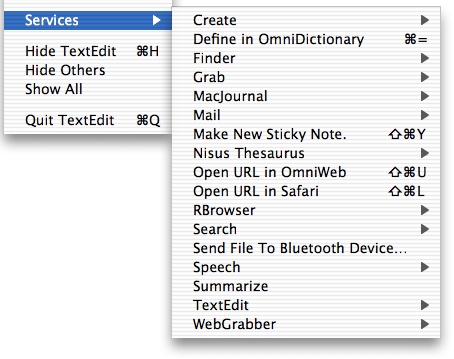 |  |  |  |  |  |  |  |  |  |  |  |  |  |  |  |  |  |
 |
| | | | | |

|
 |
I had been thinking about putting something like this together for quite some time now, but hadn't gotten around to it.
Basically, I've been using TextEdit as my primary word processor for a few years now. On it's own, TextEdit is a nice app (specially for the price), but the thing that is so special about TextEdit is that it is a Cocoa app... which means it can get a lot of help from other Cocoa apps to help make it a great app!
This is an outline of some of the things that I've done to my system to make the most of TextEdit.
The Basics:
TextEdit is gifted with Services provided by Mac OS X (and other Cocoa apps). That means that you have access to things like spell checking, speech and text services.
The system wide spell checker uses the same spelling dictionary used in other apps like Safari, OmniWeb and Mail. So if you teach it a word in one app, it'll know it for all apps. Also, if you ctrl-click (or right click) on a misspelled word a contextual menu pops up with most of the options you would find in the normal spell checker window (including it's guess at the word). |
 |
|

|
 |
| Using the system's text services, TextEdit actually handles ligatures better than some professional apps (like Illustrator for an example) which are Carbon based. And these services where up graded for 10.3 (you'll find a nice write-up on them here). |
 |
| |

|
 |
One of the additions made in 10.3 is a styles pull down menu on the tool bar. You can go through and set up a section of text (as I recall: font, size, italic, bold, indentation and the like) and save it as a style you can use over again later in another appropriate section or similar document.
Also, by default TextEdit pops up in a mode which makes people dismiss it very quickly. That is it looks like SimpleText because it is not in wrap window mode (wrap is WYSIWYG for printing). This can be fixed by a check box in the defaults.
Another difference between TextEdit and SimpleText is that TextEdit can handle images (PDF, TIFF, JPEG and GIF) within the body of a document and quite a bit of content formating.
A hidden feature of TextEdit is it's ability to add page breaks. This is most likely because it can't actually save the page breaks in finished documents (I've only tried rich text format though), but it can be used for printing and saving as a PDF. You click on the document at the place you want the page break and then hit ctrl-q-ctrl-l (where l is the lower case version of L). This should be used for preparing a document for printing (or saving to PDF) as it is not saved within TextEdit's RTF/RTFD format.
File Types
TextEdit can work with a number of file types. It can read RTF/RTFD, TXT, HTML and DOC (in the 10.3 version) formats. It can save to RTF/RTFD, TXT, PDF (via print services) and DOC (also in the 10.3 version) formats. |
 |
| | | | | |

|
 |
Helpers for TextEdit
As pointed out earlier, being a Cocoa app means TextEdit can get help from any number of apps that are willing to share their abilities via Mac OS X's services system.
|
 |
| | | | |

|
 |
TextExtras
TextExtras gives you additional controls over Apple's text services in any Cocoa app which uses them. There are Rhapsody and OPENSTEP version of TextExtras along with the 10.0/10.1 and 10.2 and later versions (it seem to work fine in 10.3 from what I can see).
Nisus Thesaurus
It is nice to have a spell checker, but when you need to know what a work means or find a replacement for it, you need something more... and this is that something more! It works great! Highlight a word in the document then go to the Services menu to Nisus Thesaurus and it'll look up the word and give you options for replacing it. |
 |
| | |

|
 |
OmniDictionary
Even though Nisus Thesaurus is great, it isn't a replacement for OmniDictionary. OmniDictionary checks a number of online dictionaries to provide you with a number of complete definitions. Like Nisus Thesaurus, OmniDictionary is accessible via the Services menu. This app first appeared in the PowerPC version of Rhapsody as I recall. |
| | | |

|
 |
On my Rhapsody for Intel systems I've been using DigitalWEBster . It isn't as nice as OmniDictionary as it has to use OmniWeb to display the web page of the online dictionary it uses. Still, nice to have it at hand in the services menu.
Create
Stone Designs Create shares a number of it's features with other applications... including TextEdit. It can replace a selected section of rich text with an HTML version of the same (with tags for things like fonts, sizes, bold and italic text). It can also replace a selection of rich text with an image of that text (using the font for that text and saving the image as an antialiased JPEG or TIFF).
Versions 10.0 for Rhapsody and 5.x for Rhapsody and OPENSTEP supply different services. I have both 10.0 and 5.2.1 installed on my 7500 because the services both share are unique.
MacJournal
There are times when I'm composing a document in TextEdit (or a post in OmniWeb) where I realize I would like to have it saved for quick access. MacJournal can grab a selected body of text from any Cocoa application and make a new journal entry from it. |
 |
| |

|
 |
FontSight
While not free, FontSight adds a font menu to any Cocoa app letting you bypass the fonts window to change fonts in your document.
Well, those are the things I can think of off hand that I've done to make the most of Apple's little text editor.
Oh, I also changed the icons for TextEdit using these icons (designed by Joerie Mortelmans). I figured than app this cool (thanks to it's helpers) deserved something a little better. |
 |
| | | | | | |
 |
|